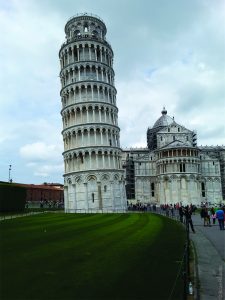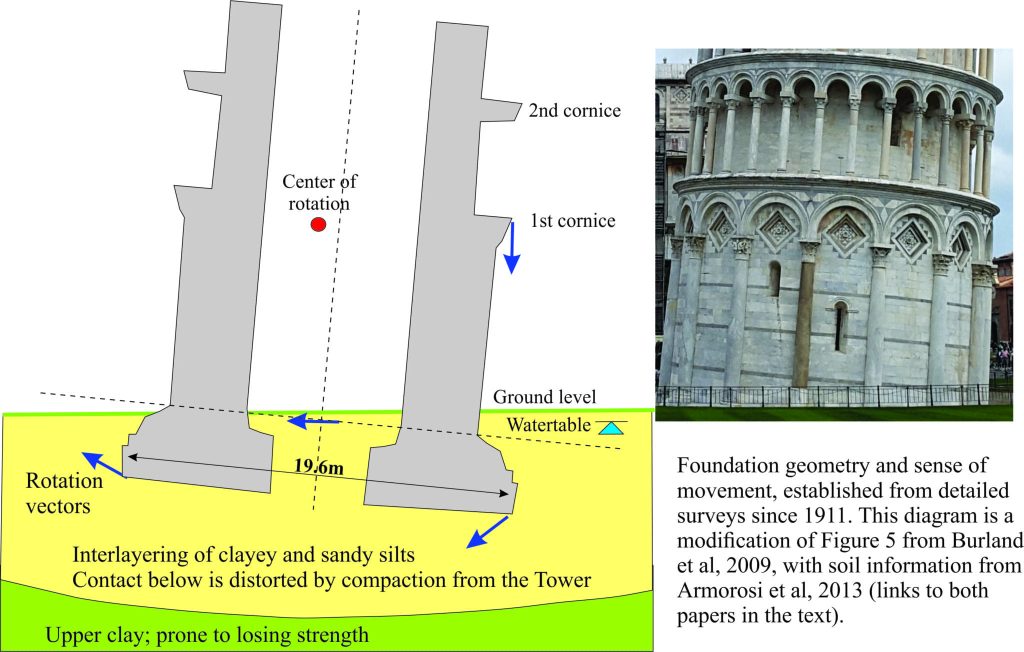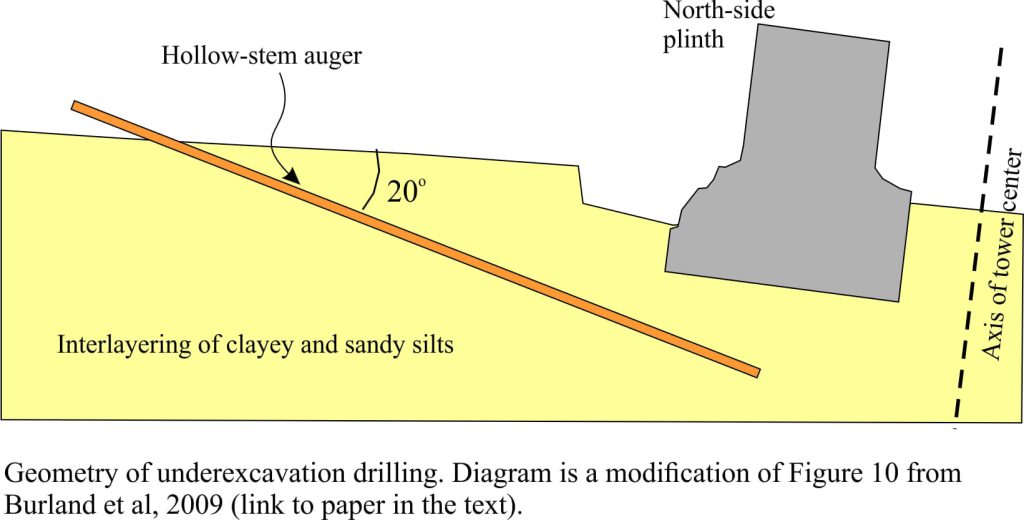Sunday in Pisa proved to be a welcome change from the usual tourist-cramped, shoulder-barging throngs of popular attractions in Tuscany. No problem finding a seat in a decent café, en route to the Piazza del Miricoli. Cross the street, turn a corner and there – the massive, white-marbled Pisa Duomo, Romanesque grandeur with a veneer of 21st Century scaffolding. But the sense of balance normally attributed to cathedrals, is disrupted by the stand-alone bell tower that leans precariously, like a drunk looking for a lamppost. The Leaning Tower of Pisa has been looking for a lamp-post for almost one thousand years. And for a thousand years, people have been drawn to the tower not because it is particularly beautiful, but because it looks like it is about to fall over.
[ Most of the geotechnical and engineering information has been gleaned from two excellent papers by Prof. John Burland (Imperial College London) and colleagues; 2009 and 2015.]
I suspect that most visitors to these peaceful surrounds have little idea of the anguish, that until a few years ago, was foisted upon Pisa city, historians, and local businesses by the imminent collapse of this icon. Innovative geotechnical intervention has, at the very least, postponed such an event.
Construction of the Cathedral began in 1093. The foundations for the bell tower were laid down in 1173. It was completed in 1372; a rather protracted completion date even by Medieval standards. Apparently, Florence and Pisa needed a couple of wars in the interim to sort out a few differences; the Black Plague didn’t help either (mid 1300s). The first inkling that something was amiss with the construction followed completion of the first cornice, with the foundation settling noticeably on its south side. As construction progressed, in fits and starts, the builders very cleverly made a series of adjustments with successive cornices (seven in all), such that the tower axis is slightly curved. The eighth cornice, the bell tower, is noticeably off-centre.
The foundations continued to sink over the centuries. By 1993, the base of the tower had tilted 5.4o, such that the 7th cornice overhung the first by 4.1m, an alarming degree of imbalance that presaged total collapse. Detailed surveys, that began in 1911, also indicated that the rate of tilting was increasing. Surprisingly, the surveys further indicated that the centre of tilting, or rotation, was not along the southern foundation, but at the level of the first cornice, several metres above the foundation.
Although the risk of the tower simply falling over seems fairly obvious, there is the added problem of failure in the tower masonry itself. Tilting increases the stresses (pressures) on masonry components in the lower part of the tower; some parts of the structure have already developed stress fractures.
Under what conditions were the original foundations laid? The Pisa coastal plain has been populated since at least 5000-6000 years ago (Neolithic), with the old city environs drained by the ancestral Arno River. The Leaning Tower is located on the coastal plain between at least four old (no longer active) tidal channels. Over the last few thousand years, sediment that spilled from these channels across the plain left a complex interfingering of clay, silt and sand layers, all of which are soft and lacking in mechanical stiffness. Instability in the sediment layers is compounded by a watertable that is only 1-2m below ground level; the Tower foundations extend several metres below the watertable. The soil conditions are such that the foundations are rotating within the soft sediment in a kind of circular motion, rather than sinking into them.
In the early 1990s, there was general consensus among engineers and geotechnical folk that the Tower was in danger of rotational failure or structural collapse. A couple of interim measures were applied. In the first, steel strands were wrapped round the lowest cornice, to stabilise the masonry while it was being strengthened. In the second, 600 tonnes of lead weight were attached to the north side of the Tower, to act as a counterweight; later increased to 900 tonnes in 1995. This resulted in a slight, but not permanent improvement. But the massive lead slabs were a bit of an eye-sore.
Several other options to stabilise the tower were examined by an International Committee for the Safeguard of the Leaning Tower; apparently some discussions were quite heated, and there were plenty of accusations of corruption and incompetence. Of course, being a member of the committee could have been quite stressful – if the Tower had fallen over then everyone else would have blamed them. Notwithstanding the competing egos, a successful solution was applied.
The method of foundation stabilization is known as underexcavation. Soil extraction tubes were drilled obliquely (20-30o) to a point just below the north-side foundations (the Tower is tilting southwards). The soil was removed, leaving a cylindrical cavity that gradually collapsed (because of the pressure from the tower and overlying sediment). Collapse of the drilled tube produced small-scale subsidence beneath the foundation on its north side. In an initial trial (1999), this process was repeated in 12 holes; the tilt angle of the tower was reduced by 0.02 degrees. The trial was successful enough to justify a full-scale assault on the problem. A further 41 extraction holes were drilled. Over a period of about 30 months the tilt angle decreased by 0.5 degrees.
An additional stabilization measure involved installation wells connected to horizontal drains on the north side of the tower, to stabilize the watertable, and reduce pore pressures around the foundation. This measure has also helped reduce the tilt. By 2008 the total reduction in tilt from both underexcavation and groundwater drainage was about 0.54 degrees.
A reduction in tilt of little more than half a degree doesn’t sound like much. But the measures seem to have worked; the rate of rotational failure has decreased significantly, and the tower is not presently at risk of imminent collapse. Geotechnical and engineering ingenuity prevailed. This is good news. There is now little sign of the drilling and excavations across the freshly mowed lawns surrounding the Tower; all the lead slabs have gone, and it seems as if nothing much has changed. The Tower still leans precariously, which is what the city, the vendors and ticket hustlers wanted. After all, why would anyone want to visit ‘a tower that no longer leans?





















2 thoughts on “Stabilisation of an architectural icon; the Leaning Tower of Pisa”
Pingback: home page
Pingback: precarious